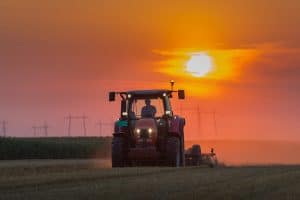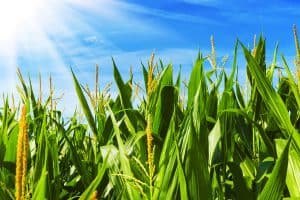Last month I closed my column suggesting that the limited supply of farmland and the principal of economic scarcity would yield a consistent long term increase in value. While my economics professor did not call me to poke holes in my judgments, I have taken myself to task this month in taking a closer look at farmland values and the economic principles driving its value. The purpose of this column is not intended to be a testament or full examination to all those economic forces which do contribute but instead it will investigate a few key principals to expand on in greater detail. Clearly there is great evidence for the cycles of farmland value and farmland is often referenced as the bell weather curve of the overall industry.
The last serious decline to farmland value occurred in the 1980s. Since then, annual growth in some states has risen in the double digit range, while between 1994 and 2004, the national average farm real estate value increased between 2 and 4 percent. Contrasting this to 2005 and 2006 they increased by 16 and 10 percent, respectively. The recession of 2008 to 2009 did bring some modest dip in farmland value, the hardest hit states were those with greater levels of suburban development and urbanization, a factor very well understood on the Eastern Shore of Maryland and other Mid Atlantic States. In 2010 to 2011 states in the Corn Belt and Great Plains experienced significant growth in cropland values including a 31 percent spike in Iowa. While prices sky rocketed in these bread basket States, areas of the Southeast and Northeast experience declines in value as transitional influences changing land use in these more urbanized markets continued to trail off. Greater detail on this research can be garnered from the September 2012 edition of the Economics of Food, Farming, Natural Resources and Rural America Journal produced by USDA’s Economic Research Service.
Farmland values are shaped by a wide array of issues like urbanization and land use change, but those transitional land uses are easier to understand. Today the impact of national farm policy, energy policy as it relates to ethanol production, as well as the access of US markets to reach the growing global demand for animal protein all prove to be significant influencers in the equation. The less transparent factors include the effect of interest rates and the opportunity cost of capital, farm rents and farm incomes. Understanding these economic fundamentals will provide a little “inside baseball” to analyze the economics driving farmland values. The fundamental factors required for a fundamental analysis of farmland values is farm rent and interest rate or the cost of capital often referred to as opportunity cost. The opportunity cost on capital also represents the discount rate on future earnings which contribute to the underlying value analysis.
In a recent article published by the Agricultural and Applied Economics Association in Choices in the second quarter of 2011 the author Brent Gloy described this fundamental analysis in this way:
Farmland Value = Farm Income / Discount Rate – Income Growth Rate or (capitalization rate)
In simple terms the agricultural land value is a function of the land rent divided by the discount rate of future income which can also equate to the capitalization rate of money in a given investment. Today’s interest rate of 4% represents a fair capitalization rate for the opportunity cost of using money to invest in farmland versus other assets. Based on this equation a land rent of $150 per acre with a discount rate of 4% would yield a multiple of 25 per dollar of income off the farm and under this scenario would yield a per acre value of $3750 per acre. The difficulty in this approach is simplifying complex agricultural incomes and costs of capital to simple arithmetic and as Mr. Gloy states, these insights must be viewed as a guide and clearly not as an absolute value. Broadly and generally this is highly simplified version of reality when it comes to agricultural markets and in no way addresses all the value associated with owning agriculturally based land. Nonetheless, it is an interesting investigative approach to land investment analysis and a tool that can be used to subjectively evaluate fundamental principles of land value. If applied locally, this analysis will demonstrate the presence of additional values above basic agricultural values internalized by farmers and investors in purchasing land around the Eastern Shore of Maryland.
There are clearly supply side constraints to quality farmland and that is an acceptable point, yet the demand side factors shaping agricultural markets are so dynamic and volatile they seem more important in the short run in understanding land values. The analysis discussed here makes considerable assumptions about future demand that are wildly difficult to predict as farm incomes depend today on National energy and environmental policy as much as it depends on feeding people. Agriculture is now tied to oil markets and the influences that face those marketplaces as well. According to Gloy, demands from the energy and food sector account for roughly 20 million acres of U.S. soybean and U.S. corn production each and together these 40 million acres equates to a quarter of the 2010 harvested acres per crop. Without argument the demand side of this equation is critical.
While there are a myriad of factors influencing agricultural markets and land values today the complexities also in my opinion add to the utility of the land by increasing the number of actors with skin in the game to its value. These economic forces add a number of opportunities for shaping value in the market place and ultimately this is positive factor as the increasing utility of an asset makes it less susceptible to drastic changes by a singular market force. The key to understanding farm land values clearly rests in the assumptions made and confidence about future conditions relating to demand side as well as factors like the opportunity cost of capital and trends in the cost of lending. These are basic fundamentals to be considered in subjectively understanding farmland values, and while there is no absolute analysis to measure the exact worth of the farmland market today, I am hopeful this investigation will earn me a better mark with my economics professor.
This content may not be used or reproduced in any manner whatsoever, in part or in whole, without written permission of LANDTHINK. Use of this content without permission is a violation of federal copyright law. The articles, posts, comments, opinions and information provided by LANDTHINK are for informational and research purposes only and DOES NOT substitute or coincide with the advice of an attorney, accountant, real estate broker or any other licensed real estate professional. LANDTHINK strongly advises visitors and readers to seek their own professional guidance and advice related to buying, investing in or selling real estate.










Add Comment